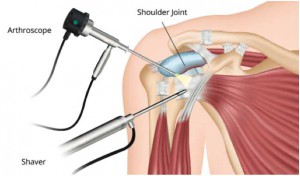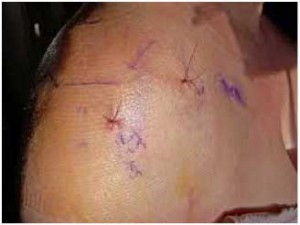Shoulder Arthroscopy
 Shoulder Arthroscopy is surgery that uses a tiny camera called an arthroscope to examine or repair the tissues inside or around your shoulder joint. The arthroscope is inserted through a small cut (incision) in your skin. Shoulder Arthroscopy may be recommended for these shoulder problems: A torn or damaged cartilage ring (labrum) or ligaments, Shoulder instability, a torn or damaged biceps tendon, a torn rotator cuff, a bone spur or inflammation around the rotator cuff, Inflammation or damaged and loose tissue that needs to be removed.
Shoulder Arthroscopy is surgery that uses a tiny camera called an arthroscope to examine or repair the tissues inside or around your shoulder joint. The arthroscope is inserted through a small cut (incision) in your skin. Shoulder Arthroscopy may be recommended for these shoulder problems: A torn or damaged cartilage ring (labrum) or ligaments, Shoulder instability, a torn or damaged biceps tendon, a torn rotator cuff, a bone spur or inflammation around the rotator cuff, Inflammation or damaged and loose tissue that needs to be removed.
Preparation before Shoulder Arthroscopy Procedure
Tell your health care provider what medicines you are taking. This includes medicines, supplements, or herbs you bought without a prescription.
During the 2 weeks before your surgery:
- You may be asked to stop taking medicines that make it harder for your blood to clot. These include aspirin, ibuprofen (Advil, Motrin), naproxen (Naprosyn, Aleve), and other medicines.
- Ask your health care provider which medicines you should still take on the day of your surgery.
- If you have diabetes, heart disease, or other medical conditions, your surgeon will ask you to see your doctor who treats you for these conditions.
On the day of surgery:
- You will likely be asked not to drink or eat anything for 6 to 12 hours before the procedure.
- Take the medicines your health care provider told you to take with a small sip of water.
- Your health care provider will tell you when to arrive at the hospital. Be sure to arrive on time.
Shoulder Arthroscopy Procedure
 You will likely receive general anesthesia for Shoulder Arthroscopy surgery. This means you will be asleep and unable to feel pain. Or, you may have regional anesthesia. Your arm and shoulder area will be numbed so that you do not feel any pain. If you receive regional anesthesia, you will also be given medicine to make you very sleepy during the operation. During the procedure, the surgeon:
You will likely receive general anesthesia for Shoulder Arthroscopy surgery. This means you will be asleep and unable to feel pain. Or, you may have regional anesthesia. Your arm and shoulder area will be numbed so that you do not feel any pain. If you receive regional anesthesia, you will also be given medicine to make you very sleepy during the operation. During the procedure, the surgeon:
- Inserts the arthroscope into your shoulder through a small incision. The scope is connected to a video monitor in the operating room.
- Inspects all the tissues of your shoulder joint and the area above the joint. These tissues include the cartilage, bones, tendons, and ligaments.
- Repairs any damaged tissues. To do this, your surgeon makes 1 to 3 more small incisions and inserts other instruments through them. A tear in a muscle, tendon, or cartilage is fixed. Any damaged tissue is removed.
Your surgeon may do one or more of these procedures during your operation:
After the Shoulder Arthroscopy Procedure
Follow any discharge and self-care instructions you are given. Recovery can take 1 to 6 months. You will probably have to wear a sling for the first week. If you had a lot of repair done, you may have to wear the sling longer. You may take medicine to control your pain. When you can return to work or play sports will depend on what your surgery involved. It can range from 1 week to several months. Physical therapy may help you regain motion and strength in your shoulder. The length of therapy will depend on what was done during your surgery.
Risks:
Most patients do not experience complications from Shoulder Arthroscopy. As with any surgery, however, there are some risks. These are usually minor and treatable. Potential problems with arthroscopy include infection, excessive bleeding, blood clots, and damage to blood vessels or nerves.
